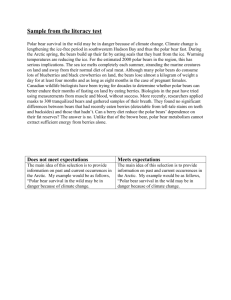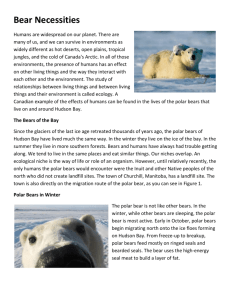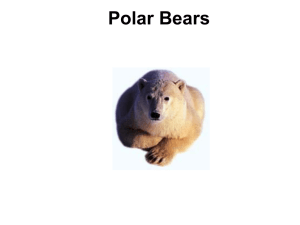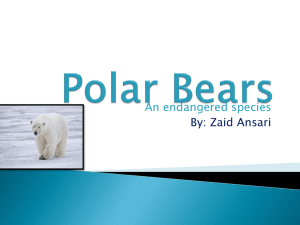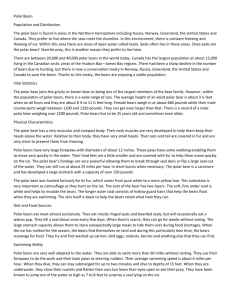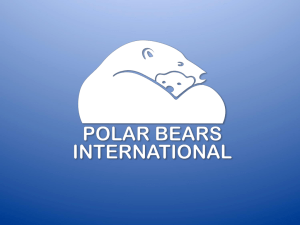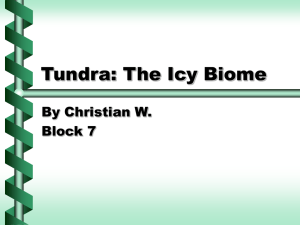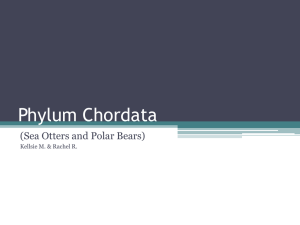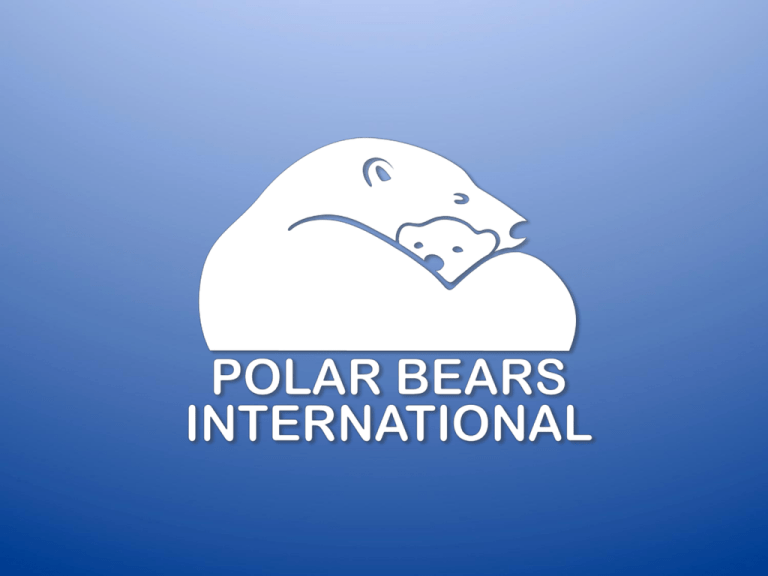
Polar Bears in a Warming World:
A Future in Jeopardy
The polar bear is the iconic symbol of the Arctic. Its
Latin name is Ursus maritimus, which means sea bear.
Polar bears live in the circumpolar north in the U.S. (Alaska),
Canada, Russia, Greenland, and Norway. Approximately 2/3 of
the world’s polar bears are thought to occur in Canada.
Scientists have
identified 19
subpopulations of
polar bears
throughout the
Arctic.
The bears are not
evenly distributed.
Instead, they’re
found where the sea
ice is most productive
for hunting seals.
Polar bears are
perfectly adapted
for life in the Arctic.
They’re able to
survive in a harsh
environment where
temperatures can
plunge to -60°F.
Polar bears are most at home on the sea ice surface.
They use ice
for …
•Hunting seals
•Locating mates
• Breeding
• Maternal dens
(sometimes)*
• Caring for their
young
Polar bears
feed almost
exclusively on
ringed and
bearded seals
which they
catch from the
sea ice surface.
There is no evidence polar bears will be able to survive on
terrestrial foods or routinely catch marine mammals on land.
166°
156°
146°
136°
126°
116°
Polar Bear 5809: Movements and Observations
21 year old adult female was 400 pounds in April
of 1998 after spending the winter in a den.
She was first captured as a yearling with her brother
and 9 year old mother in the McKenzie River Delta.
Aug 23 '98
&
&
& &
76°
Jul 26 '98
&
&
&&
&
#
Y
&
& &
Sep 13 '98
#
S
&
&
&
&
76°
&
&
&
&
Capture
Observation
Movements Determined
by Satelite Tracking
&
&
116°
Oct 11 '98
&
&
&
&
&
&
&
& &
&
&
&
Aug 22 '99
&&
&
&
&
71°
&
&
&&
&
&
&
&
&
&
Jun 6 '98
71°
&
&
Captured
Nov 5 '97
&
&
&
&&
&
& &
&
#
Y
&
&&
&
&
&
&
Nov 14 '99
&
&
&
&
&
X
(&&&
&
#
146°
Jan 09
&
#
Y
X
(
&
&
50
New
Year's
2000
&
&
&
&
&&
&
&
&
&
&
&
&&
&
&
May
9 '98
&
&
&&
Denned in Angun River
Winter 98 - S pring 99
156°
&
&
&
&& & &
&
&&
&
&
& &
&
0
&&
&
& &&
&
&
&
&&
Captured
Apr 16 '98
Given Radio
&
& &
Hallow een '99
Feb 26
&
100
150
200
&
#
Y
Captured
Apr 12 '79
Area
of
Map
250 Miles
136°
126°
Wild polar bears are the most mobile of non-aquatic mammals.
As with other species, scientists have used GPS collars to track
their movements in order to gather information that could
be used to more effectively manage them.
If polar bears are so perfectly adapted
to the Arctic, why is their future in jeopardy?
Quite simply: Their habitat literally
melts away in a warming world.
Changes to the polar bear’s sea ice habitat due to global warming are
the single biggest threat to the bears. The rapid arctic warming is
caused by a build-up of greenhouse gases in the atmosphere.
Sea Ice Loss Video
What do habitat changes mean for polar bears?
•
•
•
•
•
•
Reduced access to prey
Drop in body condition
Lower cub survival rates
Drowning
Cannibalism
Loss of access to denning
areas
• Declining population size
Why is this happening?
• For the last million years,
the Earth’s CO2 levels and
the global mean
temperature held fairly
steady.
• Since the industrial age,
however, rising GHG levels
have caused a steadily rising global mean temperature.
Rising
temperatures =
decline in extent
and quality of
sea ice.
No sea ice =
no polar bears.
Your actions can make a difference!
Reason for hope…
What can you do to help?
Two things…
• Individual actions can make a difference. You can
make individual actions multiply when you inspire
others to join your activity, particularly when you
create change on a community level and influence
the marketplace through your buying habits.
• We must understand the carbon cost of doing
business—and corporations, industry, and
governments must embark on initiatives that will
solve this problem.
Here are some things you can do:
• Recycle
• Turn off lights and
electronics
• Set up a no idle zone
at school
• Use reusable bags
• Walk or bicycle
• Plant trees
• Grow your own
vegetables
• Drink water from a
reusable container
• Be a conservationist
Here are some things you can do:
• Complete an energy audit
of your home
• Be a smart consumer
• Replace old appliances
with Energy Star
• Combine errands or
carpool to drive less
• Weather-proof your home
• Use a programmable
thermostat to save energy
• Limit the time your vehicle
idles
• Vote for candidates who
support action on climate
change
On behalf of polar bears everywhere,
PBI thanks you!
2013 © POLAR BEARS INTERNATIONAL
Photos: © Daniel J. Cox / www.NaturalExposures.com
© BJ Kirschhoffer/Polar Bears International • © Steven C. Amstrup/Polar Bears International
All Rights Reserved. Marks and text appearing in this presentation including,
but not limited to, the Polar Bears International name, logo, and programs are trademarks,
registered trademarks, or service marks of Polar Bears International.



